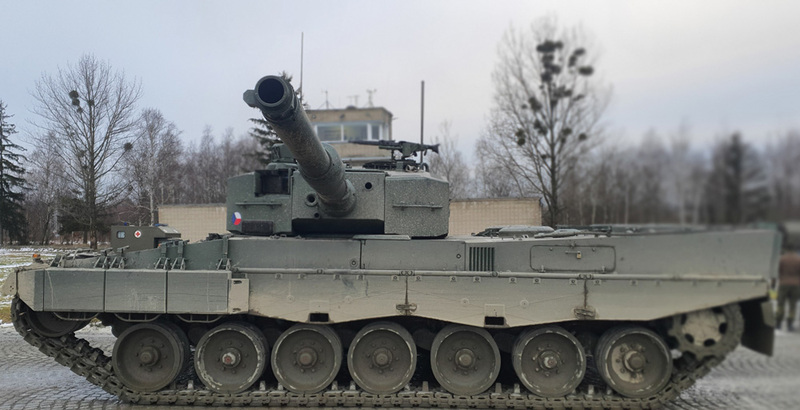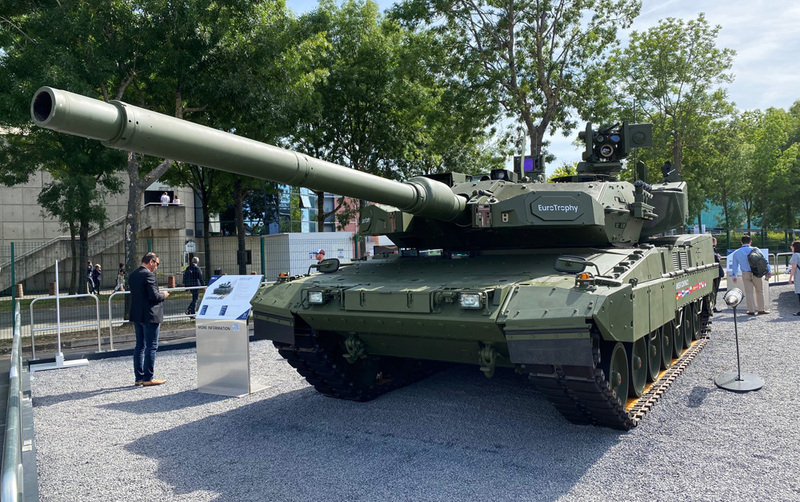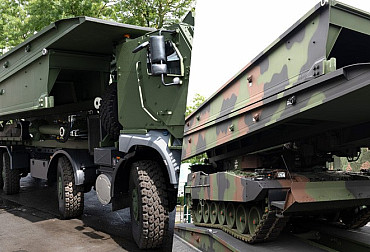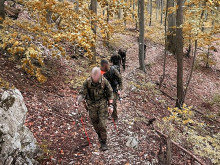New Leopards 2 for the Bundeswehr and Norway – a promise for the Czech army in the future
The Czech Army already has the first of 14 Leopard 2A4 tanks donated by the German government. This type of tank has also already passed the military tests, so in principle nothing prevents their service in the Czech Armed Forces. However, the 14 battle tanks plus one recovery vehicle, plus the older Leopard 2A4, are just the beginning of the transition to Western technology and a harbinger of the rearmament of the tank forces that is yet to come.
 Picture: The Leopard 2 A4 tanks will primarily be used to train soldiers of the 73rd Tank Battalion, including active reserves. They will ensure a smooth transition to the new type of main battle tank and its implementation into use in the Czech Army. | Jan Zilvar | CZ DEFENCE
Picture: The Leopard 2 A4 tanks will primarily be used to train soldiers of the 73rd Tank Battalion, including active reserves. They will ensure a smooth transition to the new type of main battle tank and its implementation into use in the Czech Army. | Jan Zilvar | CZ DEFENCE
The Leopard 2A4 tanks that the Czech army will receive this year cannot replace the T-72M4 CZs that have been used so far. For one thing, they are only 14 machines and, moreover, their equipment is not among the most modern that the current and future battlefield requires. The Leopards will primarily be used for training crews according to NATO standards, but in the future they could undergo modernisation, similar to the tanks of the same type of the German Bundeswehr. In fact, representatives of the Ministry of Defence have already expressed themselves in this sense. In the near future, the 2A4 Leopards will only complement the T-72M4 CZs, which are undergoing technical evaluation and partial modernisation.
Thus, the army will reinforce and adopt Western technology as far as tanks are concerned. However, there is no question of a major modernisation, which will come only with completely new tanks, which the army wants to acquire in the coming years. The donated tanks will undergo technical inspections and repairs before delivery, so they will be fully functional and combat-ready. This guarantees long service life and also the potential for future upgrades. However, from today's perspective, it is no longer ideal that the army will operate two completely different types of tanks for several years. Therefore, the logical solution for the future seems to be to replace the T-72 tanks with more Leopard 2s, but in the latest design, and to upgrade the donated machines to the most similar standard. The Leopard 2 is one of the most widely used and most powerful tanks of Western provenance. It is also the only tank currently being produced on the European continent, specifically by Krauss-Maffei Wegmann (KMW). These are also arguments that speak for the Leopard.
As far as the modernisation of older machines is concerned, it should pose no problem, as KMW has extensive experience in modernising tanks from the Bundeswehr's armoury. The company has carried out extensive upgrades for the German armed forces under several programmes, most recently to the Leopard 2A7V standard. The A7 version was first presented at Eurosatory 2010. Since then, continuous development has been underway, with production machines able to be shaped exactly according to customer requirements. In addition, various advanced solutions and sub-systems can be ordered from manufacturers of communication equipment, optoelectronic equipment, active protection systems, ammunition, etc. This is good news for the Czech army, as if it were to acquire Leopard 2 tanks, they would be significantly more advanced than those currently deployed in NATO and non-NATO armies. One possible form of the future Leopard 2 was represented by a demonstrator on display at Eurosatory 2022.
 Picture: One possible form of the future Leopard 2 was represented by a demonstrator on display at Eurosatory 2022 | Michal Pivoňka / CZ DEFENCE
Picture: One possible form of the future Leopard 2 was represented by a demonstrator on display at Eurosatory 2022 | Michal Pivoňka / CZ DEFENCE
For the Czech army, the information that Norway and Germany will buy new Leopard 2 tanks may also be very interesting. The decision to buy them was made a short time ago, so they will represent a completely new level within the Leopard 2 tank family. The Norwegian government has decided to buy 54 Leopard 2 tanks in the latest variant, with an option for 18 more, with deliveries to take place in the second half of this decade. The decision came after a rather lengthy selection process and tests of two contenders - KMW's Leopard 2 and Hyundai Rotem's Korean K2 Black Panther tank.
The evaluation was that both tanks meet the requirements of the army and the Ministry of Defence. However, familiar arguments spoke in favour of the German tank. First of all, the large number of users in Europe, the Norwegian army itself uses the older type of Leopards, and the German tanks are also in the arsenal of the armies of neighbouring countries - Sweden, Norway, Denmark and Finland. Another important fact is that the manufacturer is based in Germany, so the logistics chains are not long. There is also the LEOBEN support programme, which is available to all Leopard tank users.
According to Europäische Sicherheit & Technik, the German Ministry of Defence plans to purchase 18 Leopard 2A8 tanks. It is not without interest that these will be the first newly produced tanks for the Bundeswehr in more than 30 years. Until now, the German army has been acquiring Leopard 2s in the latest versions through upgrades and conversions of older tanks. It is more than likely that the ministry will also order additional tanks from KMW by way of an option. The Leopard 2A8 will reportedly be based on the last production variant of the Leopard 2A7HU for Hungary so far.
 Picture: The design of the new Leopard 2A8 tank will be based on the Leopard 2A7HU main battle tank for the Hungarian army (pictured) | Krauss-Maffei Wegmann (KMW)
Picture: The design of the new Leopard 2A8 tank will be based on the Leopard 2A7HU main battle tank for the Hungarian army (pictured) | Krauss-Maffei Wegmann (KMW)
According to the latest information, the planned new Leopard 2A8 type is seen by the German Ministry of Defence as a transition to a significantly modified version of the Leopard 2AX, which is expected to be introduced towards the end of this decade. The Leopard 2A8 is likely to have much in common with the demonstrator unveiled at Eurosatory in June 2022 and during NATO Days in Ostrava in autumn 2022. Neither the basic concept of the tank nor the size and deployment of the crew will change. The driver will have his place in the front right of the hull, while the commander, gunner and loader will operate in the battle turret. The 2A8 version will also reportedly stick with the Rheinmetall Rh 120 L55A1 gun, but will once again receive improved protection based on third-generation composite multi-layer armour, as well as enhanced mine-resistance of the hull and protection against cluster munitions attacking from above.
The tank driver will have a combined day and night vision system that integrates a thermal imaging camera and a low-light amplifier for forward and rearward vision. This advanced system will greatly improve situational awareness and allow better orientation in low-light conditions. The optoelectronic equipment, fire control system and communications systems will also be improved. The engine will have a higher power output of 1,193 kW and the tank will also receive a more powerful auxiliary unit with a power output of 20 kW. The Leopard 2A8 will also be equipped with the EuroTrophy active protection system, which is derived from the proven Israeli Trophy system. This will change the shape of the turret to some extent compared to earlier versions. It is not yet certain whether a remote-controlled weapon station will be installed on the tower.
Leopard 2s are used by the armed forces of 22 countries and are also in service in all Central European countries, i.e. Germany, Poland, Austria, Hungary, Slovakia and the Czech Republic. KMW has produced more than 3,500 Leopard 2s and today they are assembled mainly in Munich and Kassel. The manufacturer also has an elaborate support programme for Leopard tank users called LEOBEN (Leopard-benutzende Staaten). The LEOBEN programme enables sharing of tank operating experience, sharing of logistics and brings economic savings. The LEOBEN countries work closely together in research and development, tank upgrades, repairs, provision of spare parts or provision of ammunition to make the operation of Leopard 2 tanks as cost-effective as possible. Thanks to the LEOBEN programme, Leopard 2 users can rely on strategic cooperation to make tank operations cheaper.
All these facts are strong arguments for the replacement of the T-72 in the Czech army by the Leopard 2. No other type of Western tank that could be considered for the rearmament of the Czech tank forces can be such a comprehensive solution, not only because they are no longer in production. Tanks from distant regions, such as the K2 from Korea, may pose a problem in terms of excessively long and transport-intensive logistics chains and inadequate service facilities, as no one in Europe operates these tanks (except Poland in the future). This would be compounded by the relatively small number of machines that the Czech army wants to introduce into the arsenal. In the case of the K2, even a link to Polish production and repair capacities would not be an option, as Poland must first build them and then use them primarily for itself, given the urgent need to rearm its tank army.
As far as Abrams tanks are concerned, Poland is acquiring them and Romania is also planning to do so. However, both countries host relatively large US Army formations (specifically mechanised ground units) and can therefore benefit from a logistics support system together with the US Army operating on their territory. However, this is not the case in the Czech Republic; moreover, the operation of these gas turbine tanks is financially and logistically much more costly and complex than conventionally powered machines. This is even more pronounced if only dozens of machines are operated, as in the case of the Czech army.





















